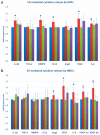Release of Pro-Inflammatory/Angiogenic Factors by Retinal Microvascular Cells Is Mediated by Extracellular Vesicles Derived from M1-Activated Microglia
- PMID: 38203187
- PMCID: PMC10778795
- DOI: 10.3390/ijms25010015
Release of Pro-Inflammatory/Angiogenic Factors by Retinal Microvascular Cells Is Mediated by Extracellular Vesicles Derived from M1-Activated Microglia
Abstract
The interactions between the neuronal and vascular sides of the retina during diabetic retinopathy (DR) have gained increasing attention. Microglia is responsible for the immune response to inflammation inside the retina, which could be mediated by paracrine signals carried by extracellular vesicles (EVs). We aimed to characterize EVs released from immortalized human microglial cells in inflammation and investigate their effects on the retinal microvasculature and the anti-inflammatory potential of thiamine in this context. M1 pro-inflammatory polarization in microglia was induced through a cytokine cocktail. EVs were isolated from the supernatants, characterized, and used to stimulate human retinal endothelial cells (HRECs) and pericytes (HRPs). Microvascular cell functions and their release of pro-inflammatory/angiogenic factors were assessed. M1-derived EVs showed increased content of miR-21, miR-155, CCL2, MMP2, and MMP9, and enhanced apoptosis, proliferation, migration, and ROS production in HRPs and HRECs. IL-1β, IL-6, MMP9, CCL2, and VEGF release increased in HRPs exposed to M1-derived EVs, while HRECs showed augmented IL-6, Ang2, VEGF, and PDFG-B. Addition of thiamine to M1-microglial cultures reverted most of these effects. In conclusion, M1-derived EVs stimulate functional changes and secretion of pro-inflammatory/angiogenic molecules in microvascular cells, exacerbating inflammatory damage and retinopathy features. Thiamine added to microglia exerts anti-inflammatory effects.
Keywords: angiogenesis; diabetic retinopathy; endothelial cells; extracellular vesicles; inflammation; microglia; pericytes; thiamine.
Conflict of interest statement
The authors declare no conflict of interest. The funder had no role in the design of the study; in the collection, analyses, or interpretation of data; in the writing of the manuscript; or in the decision to publish the results.
Figures



References
MeSH terms
Substances
Grants and funding
LinkOut - more resources
Full Text Sources
Medical
Miscellaneous

